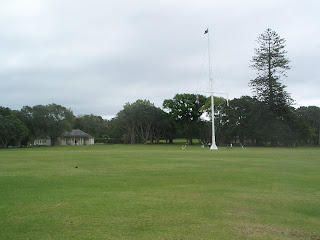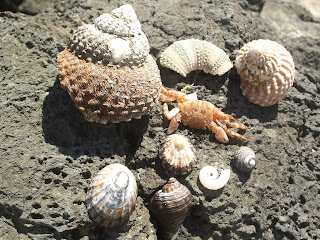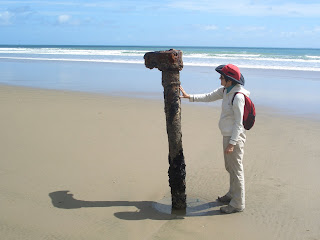
What with all the folks jumping off mountains, bridges and buildings around New Zealand, we figured it was time to jump off something ourselves. When in Rome . . . But we're getting ahead of our story. We'll come back to it shortly.
It happened by accident. In fact this whole past week was one unplanned adventure after another! The plan was to drive our tandem bike, still unridden and in its two cases, down to Wellington and to leave it with friends there until mid-January, when we get back from Australia. OK, simple enough. It's a 2-day drive if you go straight there, how can we make this fun? OK, let's go a little out of the way and visit that couple from New Plymouth we met last week on the bus trip in the Northland? Hmmm, that will take us through Waitomo.
Some of you may have heard of Waitomo. It has one of the biggest tourist traps in NZ, big enough to have caught Louise when she was here 14 years ago. 99% of the visitors go straight to the Glow Worm Caves And Underground Boat Tour, and it is a very interesting tour, at a price that keeps a few New Zealanders on Easy Street. But there is a 6 mile hiking track that goes through the countryside and up to some rivers that disappear underground, and it's free. OK, let's check that out. Hmmm, where to stay? How about this place -- "Big Bird B&B"?

First lesson, you do not ever ask for ostrich eggs "over easy" or poached, the picture notwithstanding. Host Ross "cracked" the egg for us, using a cement-cutting drill bit, and it took him almost two minutes! Watching Sesame Street, you'd never guess what a tough customer Big Bird is!

Next Ross pierced the membrane inside and shook out the contents into a large bowl, for your options with ostrich are scrambled, scrambled, or scrambled. Second lesson, bring some friends -- one egg feeds about 16 hungry people. As part of our stay we got to meet the birds, but you don't want to get too close to these guys, they sometimes tangle with lions in their native Africa, and the lion doesn't necessarily win.

Over breakfast we got to talking with Ross and Ann, and they told us about the abseiling (rappelling) company their son co-owns and that Ross works occasionally at as a guide. They sold us on the idea of jumping off a 160' cliff in the night and gliding down through the glowworms as a pleasant way to spend an evening. It was a good decision -- this was one of the most fascinating adventures we've ever taken.
Ross wasn't working that evening but one of the other guides did a great job making sure we followed all the safety rules and understood what to do. There was only one moment where Louise said "You want me to do WHAT," when our guide told us to turn around and sit on that metal bar that has nothing underneath it but those 160 feet of air.

He reminded us that we were attached both to a side safety line and to him at this point. "So if we go, you go?" "Company policy" he replied.
It was actually quite safe, and most interesting to slowly descend 16 stories through this narrow cleft. Imagine two 16-story buildings about 7 or 8 feet apart and two or three blocks long and you have an idea what this chasm looked like. At the bottom it was sandy with a little water, where we got this photo of us and the Aussie couple that joined us.

The first descent was at sunset, so there was enough light to see the walls of the cleft and the landing zone below, if dimly. As we descended each couple was attached to one guide with about 10 feet of slack rope, so you didn't have to be perfectly next to each other, but were close enough for him to check a too-rapid descent. What goes down must come up, as they say (or at least that's the hope on Wall Street these days), and the route up was constructed by them buying out every metal ladder that was for sale for 100 kilometers around, we suspect, and very firmly attaching them to the rock wall. As we ascended each 20 to 40 foot section, we attached to a fairly heavy rope with a device that slid up with us, but would have stopped us firmly had we slipped. At each landing we used carabiners attached by short ropes to our climbing harness to attach to side ropes while we disengaged from climbing rope #1 and moved on to climbing rope #2. Attach to #2, then disengage the side ropes, then move on. For 16 stories.

Now for the high point, so to speak, of the evening. It was now well past twilight, and we were experienced abseilers, so we reattached to the descending ropes, went down a few feet and showed our guides that we were firmly there, then the guides descended all the way to the bottom leaving the four of us dangling up at the top. When they gave the OK we disengaged our safety lines to the top and started descending. By holding our ropes they could tell if any of us was coming down too fast and could pull our rope taught, which would stop us (you'd have to ask a mountaineer to explain how, but we took our guides' word for it). No need, we all kept in perfect control, and could stop at any time easily.
As soon as we cleared the rim, we entered another world. The sides of the cliff were now indistinct, but covered with points of light that looked almost exactly like very bright stars, in all directions around us. It was light descending through a galaxy! Oh, look at that constellation over there! Oooooh, how about that one on the other side!!! Glow worms are funny little creatures the thickness of an average needle and not quite that long. One end lights up much like a firefly though smaller, but it stay lit all night, attracting even tinier bugs to come close and get caught on micro-thin fibers dangling in air that have been spun by the glow worm and covered by droplets of a mild acid that stuns the prey. Once the glow worm feels that familiar tug on his fishing line, he reels in a meal. Since the bugs the glow worms like to eat prefer moist environments, glow worms are plentiful in wet caves and in deep chasms like the one we were in. They live and die in one place, with a life cycle of about a year. While they seem as bright as the brightest stars, the light they give off was not enough to capture without a tripod and an exceptionally long time exposure, so we can't show you a photo, you'll just have to come to Waitomo and jump off that same cliff for yourselves!

We can however show you that walk, and it was one of the best so far! We started off with a climb up to a high point looking down at the historic Waitomo Hotel,

then across two different styles of stiles,



with some livestock nearby to show us why we needed to climb over all those stiles. At last we came to a more forested area and the trail began climbing up the sides of cliffs, in some cases hanging off the sides!


We knew there were rivers that went into and out of caves, and noticed a very small one on the way up.

Returning later, we heard voices and looked over in astonishment to see a group of those crazy Kiwis coming out of what appeared to be a water-filled hole in the hillside, dressed in wetsuits and bobbing on rubber tubes. Ah, Waitomo Glowworm Caves still packs them in, but more and more tourists are going for the stronger stuff, like tubing through the caves or abseiling into them or into chasms like us.
Further up we saw a similar-sized river -- perhaps the same one -- enter into a large cave.


The trail took us by another route into the cave, in fact into a cathedral-like chamber, where we saw the same river entering (this time from the inside out) and then exiting to the left into a much smaller, darker cave.


Back again over hill and dale to the end of yet another fantastic trek.



After a second breakfast of scrambled ostrich egg -- it tastes much like hen eggs, but a bit richer -- we drove on down to New Plymouth, on the Tasman (west) coast of the North Island. This area is dominated by Mt. Taranaki, and our first glimpse was from some 80 kilometers away where we had a picnic lunch at this picturesque road pullout.

A little further on we drove a kilometer off the highway and hiked a kilometer along another black sand beach

to a sea cave that was now a tunnel. Coming out the other side were the Three Sisters, or rather two of them, the third one apparently hiding shyly behind that headland.


Just like the Olympics in Washington, Mt. Taranki catches moisture coming off the sea and has the highest rainfall on the North Island, up to 4 meters a year (above 150 inches!) Even the lower areas are a bit wetter than Seattle, though the rain was far away the day we arrived and took this picture from the front yard of our new friends Robert and Denise.

But with all that rain, including some while we explored them, the area is famed for its gardens. Our friends kindly took us to two of them, and also to an avant-garde museum

that was turned over to this sculpture, we suppose you'd call it, of chains in various sizes that interconnected up and down staircases, over balconies, in fact throughout every corner of the museum. When the exhibit's over it will all be chipped up and sent back to the manufacturer to make into styrofoam coolers and the like.

Well the bike's been delivered and we've moved on to new adventures back up the North Island, but this blog is already moving from short story to novella so we'll save those words and pictures for the next entry. Thanks for coming along on this part of the trip.










































